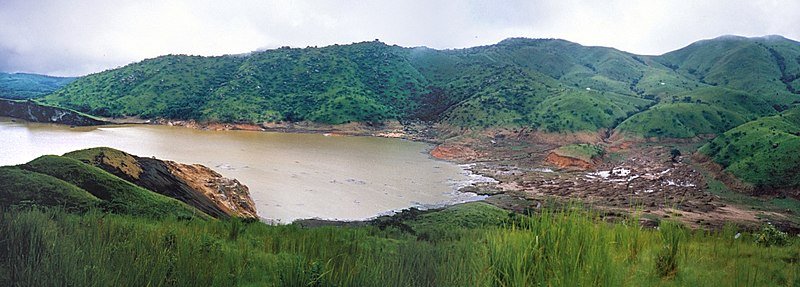Welcome to a new episode of the Bizarre Natural Phenomena series! This post is a bit gassy, so brace yourselves and put your gas masks on before we land to Cameroon (Africa). We're not going on a safari, we're only visiting a lake that 31 years ago killed more than 1700 people with CO2 gas poisoning (that's the Hitler simile for). Lake Nyos' noisy explosion rose a heavy cloud of CO2 that spread over the surrounding villages and smothered innocent people and livestock that couldn't flee away.

(Image source: commons.wikimedia.org)
News Flash: Lake Poisons 1700 People
The night of 21st August, 1986 rumbling noises starting coming from the lake. A mass of water and foam covered the the lake forming a layer as thick as 100 meters and waves as high as 25 meters rose over the surface. A heavy cloud of CO2 started travelling at 50 km/hour and covered a radius of almost 25 km, pretty much like an expanding deathly gas chamber. Since CO2 is denser than oxygen, the cloud that was formed "sat" over the ground for a couple of days. People died in their sleep and many of the ones that tried to run away were left unconscious when they breathed the CO2 in. The incident took 1,746 human and almost 3,500 animal lives over the three villages in the vicinity (Nyos, Cha and Subum). After the eruption, water levels had lowered, the blue water had turned reddish (because ferric ions came to the surface and reacted with the oxygen in the atmosphere) and lots of trees had been rooted out.
Scientists's assumptions?
The reason for this lethal CO2 outburst has been a mystery, people had been trying to find out the most sustainable theory for this catastrophe and after observations and monitoring here are some of the most possible causes:
- Earthquake: NEGATIVE
- Volcanic eruption: NEGATIVE
- Magma chamber: POSITIVE
- Landslide: POSSIBLY POSITIVE
Lake Nyos is a crater lake (the remnants of a dead volcano that got flooded with water) situated over a hole in the Earth's crust. It is 208 meters deep and covers a range of 390 acres. Volcanic activity is present over the area and therefore, scorching magma's ingredients still find a way out to the surface through the lake. The eruption that cost so many lives on that night was actually a limnic eruption.
Like a time-bomb waiting to explode
The magma chamber beneath the lake freed large amounts of CO2 that managed to gather over the lake's bottom. Right there the poisonous gas finds the perfect environment to dissolve in water (low temperature and high pressure). If a lake is shallow enough, the CO2 can escape to the atmosphere silently and without causing any inconvenience. As seasons change there is a continuous "recycling" of the water through cooling and warming that helps gas release (when water gets colder, it gets heavier and sinks causing an upwards flow of the lower level-water).
In lake Nyos' case though, the force of 20 atm (add 1 atmosphere per 10 meters in depth) allowed a great build-up of CO2 that awaited undisturbed for years. All that in combination with the climate (all-year-long hot temperatures) that doesn't leave room for such "recycling" to happen. If, by pure bad luck, anything comes to disrupt its peace, then the lake will angrily break out, releasing large amounts of CO2, just like a can of soda that pops violently after you've shaken it. It still remains unknown what happened in the first place and triggered this catastrophic "burp", but it is believed that a landslide that happened around the walls of the lake was the culprit. Thankfully, there are not many lakes like Nyos that can blow unexpectedly.

(Image source: wikipedia.org)
Learn from mistakes of the past
Since no one would want the same massacre to happen again, a system of "degassing" has been set up on the lake. Huge pipes are used to prevent CO2 high concentrations, the first one was installed in 2001 and ten years later two more were added. People have been coming back to the area, despite the risk of a new "suffocation-attack" because the land is fertile. New worries have also risen due to the "fragility" of the lake's dam. Geologist Isaac Njilah (University of Yaounde - Cameroon), stated in 2005 that the erosion over the years could lead to a collapse of the lake's walls. The bad news is that such a destruction would flood the area and release deadly CO2 amounts (a new death sweep is coming).

(Image source: wikipedia.org)
The same tactics of degassing are followed in lake Monoun (in Cameroon too), which also exploded in 1984, but luckily it did not count as many victims as Lake Nyos. Also, lake Kivu (Rwanta), the one we mentioned in one of the early posts of this series (Bizarre Natural Phenomena Vol.3 - Flammable Ice Cubes) produces huge amounts of methane, due to a bacteria population that live inside it. The country has been trying to take advantage of the gas and use it in energy production.
The SciShow episode gives a terrific presentation of the phenomenon, check their video:
References
science.howstuffworks.com
atlasobscura.com
wikipedia.org_1
wikipedia.org_2

Thank you for stopping by and giving this post a read. I hope you enjoyed it! If it got your curiosity-radar on, feel free to follow me, @ruth-girl, for more fascinating phenomena!
You can also check some of the previous articles on this series:
17 - A Skypunch
18 - Lake Baikal
19 - Mother-Of-Pearls Clouds
20 - The Hessdalen Lights
21 - St Elmo's Fire

And for those engaging with education, @steemiteducation is here to join all steemian educators in their common cause of making our job easier, more effective and more fun, because...

(Original image credits: Nick Youngson - nyphotographic.com)
Finally, the greek community of steemit is here and waiting for you to discover it! Follow the @greek-trail for daily doses of good-quality posts by wonderful writers!
Until my next post,
Steem on, people, and keep smiling!


